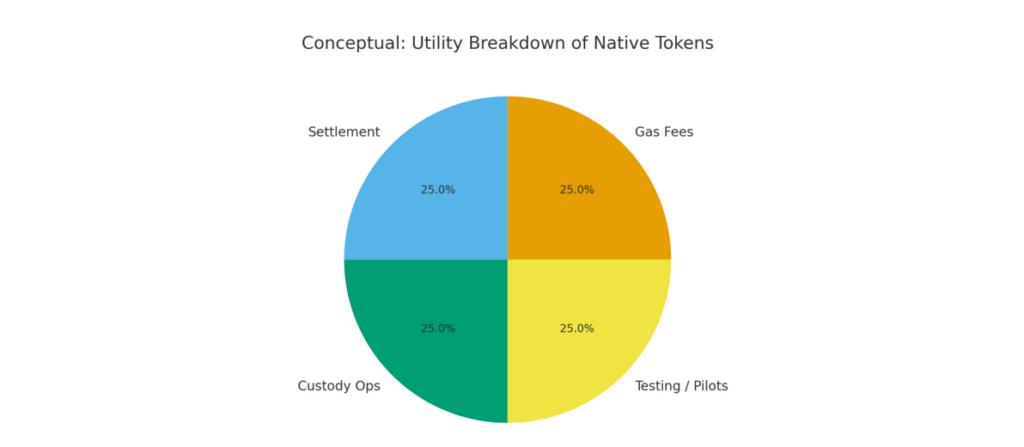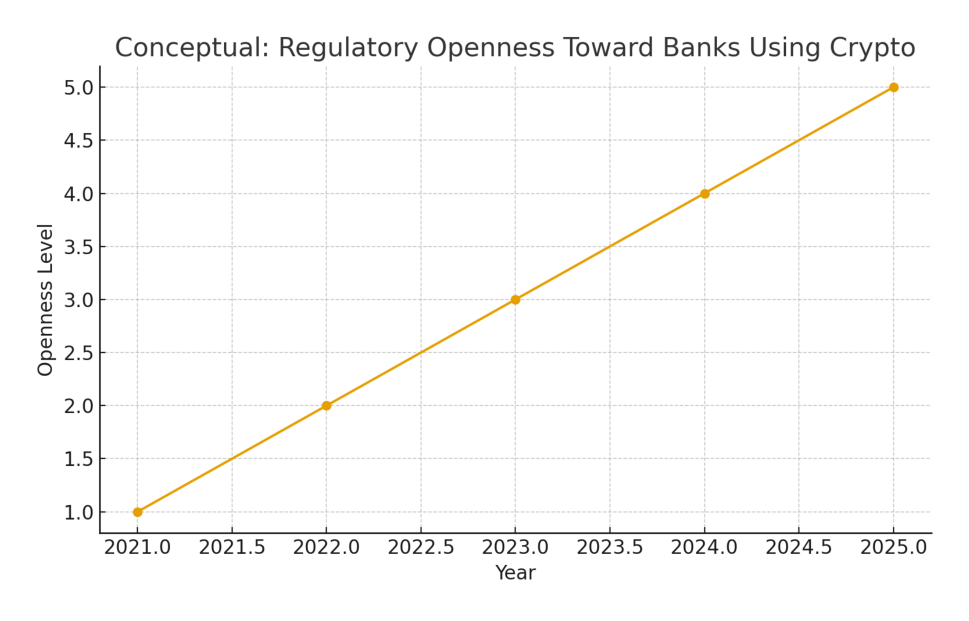
Main Points :
- The Office of the Comptroller of the Currency (OCC) has formally clarified that U.S. banks may hold minimal cryptocurrencies for paying blockchain network fees, and can engage in blockchain-related operations.
- The new guidance positions blockchain networks and native tokens as part of banks’ infrastructure, akin to foreign exchange reserves or payment network shares.
- For crypto-asset investors and blockchain practitioners, this signals a major institutional shift—with implications for token demand, new banking services, and real-world blockchain integration.
- While the rule is limited to “minimum necessary” holdings and operational use, the broader message is that regulated banks will increasingly adopt on-chain processes.
- Risk management remains central: banks must still demonstrate governance, cyber/operational controls, and third-party oversight within the existing regulatory framework.
1: Regulatory Opening for Banks and Blockchain
In mid-November 2025, the OCC issued a formal interpretive guidance stating that banks may hold the minimum amount of cryptocurrency necessary to pay network/“gas” fees associated with blockchain transactions. The guidance specifically clarifies that such crypto holdings, when tied to executing permissible banking operations on a blockchain, are allowed. The document views these holdings as analogous to traditional foreign-exchange reserves or network infrastructure stakes, rather than speculative positions.
This marks a paradigm shift: for decades, U.S. banks have operated under conservative interpretations that largely excluded on-chain native token holdings. With this guidance, regulated banks now have a clearer path to integrate blockchain networks into payment, settlement, data-registry or tokenisation workflows. For crypto practitioners and asset-seekers, the message is that blockchain infrastructure is no longer peripheral—it is becoming part of mainstream banking plumbing.
2: What the Guidance Permits — and What It Limits
The key features of the guidance can be summarised as follows:
- Banks may pay blockchain network fees (gas costs) directly, rather than relying entirely on third-party intermediaries.
- Banks may hold a minimal amount of native chain tokens (e.g., ETH on the Ethereum network) only to execute operations that the bank is authorised to perform (for settlement, custodian services, tokenised asset services, etc.).
- Banks engaging in such crypto activities must maintain robust risk-management frameworks: controls for cyber-security, operational resilience, governance, and third-party oversight.
- The guidance does not permit speculative holdings for the bank’s own account beyond what is necessary to perform the blockchain-based operations. In other words, banks cannot treat these holdings as a trading book.
- The guidance also signals that banks may test and pilot blockchain infrastructures (for record-keeping, tokenisation, DLT platforms) and hold the necessary tokens for such testing, within a controlled environment.
In short, the bank must justify that the token holding is required for the bank’s execution of authorised business. It remains a utility holding, not an investment holding.
3: Implications for Crypto Assets, Token Demand and Banking Services

From the perspective of a reader seeking new crypto asset opportunities, this regulator-driven opening is significant. Several implications follow:
Token Demand and Native Chains
When regulated banks begin to integrate blockchain networks into their operations (for example, using on-chain settlement, tokenised assets, inter-bank communication via DLT), they will require native tokens (e.g., ETH on Ethereum, or other chain tokens) to pay transaction fees. While the amount per bank may be modest initially, the cumulative effect across large incumbents could become non-trivial. This increases the utility demand side of tokens and may influence token economics.
New Banking Services and Custody Opportunities
Banks may now develop new services: on-chain custodian services, tokenised asset issuance, blockchain-based settlement layers, and direct participation in node or validator infrastructures (subject to risk frameworks). This opens new revenue streams and also creates demand for infrastructure providers, wallets, bridging services, and institutional-grade blockchain tooling—all of which present opportunities for entrepreneurs.
Bridging Traditional Finance with DeFi and Tokenisation
This guidance helps bridge the gap between traditional banking and decentralised finance (DeFi). Banks acting on-chain could integrate tokenised assets into their balance sheets or for clients—such as tokenised real-world assets, payments via blockchain, or even programmable finance workflows. For practitioners exploring blockchain use cases, the message is clear: institutional adoption is accelerating.
4: Practical Use-Case Scenarios and Strategic Themes

To make it more concrete for blockchain practitioners and investors, consider several potential scenarios enabled by this guidance:
- Tokenised Bond or Equity Settlement: A bank issues a tokenised version of a traditional asset (e.g., a bond or RE token) on a public chain. The bank holds the native token to pay gas fees when transferring or settling the token-asset between counterparties.
- Interop Payment Network: A bank acts as node or participant in a distributed ledger network supporting cross-border payments. The bank holds minimal chain tokens to process transactions and record data on-chain, thereby reducing friction and settlement time.
- Custody & Staking Services: While the guidance does not explicitly permit speculative staking, the bank could offer custody services for clients who wish to stake tokens (subject to legal/regulatory allowances). The bank might hold native tokens temporarily as part of the on-chain operation infrastructure.
- Enterprise DLT Pilots: A bank pilots a new distributed ledger for, say, supply-chain financing, tokenised receivables or trade-finance workflows. The bank holds chain tokens to pay fees in the test network or production system while operating under the approved risk regime.
For developers and infrastructure builders (including Node.js/web3.js stacks), the takeaway is: banks will increasingly integrate blockchain APIs, token-fee logic, custody rails and enterprise-grade key management into their underlying systems. If you are building tooling or services that support banks’ on-chain operations, now is a pivotal moment.
5: Risks, Governance & Regulatory Considerations

Despite the enabling stance, this guidance sets forth clear guardrails—and practitioners and asset seekers must remain aware of the following:
- Risk Management: Just because banks may hold native tokens does not mean the activity is lightly supervised. Banks remain subject to strong safety and soundness principles: cyber-security, operational resilience, compliance (AML/CFT), third-party risk, governance frameworks.
- Disclosure and Internal Controls: Banks must ensure that the token-holding and blockchain activity are properly integrated into their internal control frameworks, risk appetite statements, board oversight, audit functions and regulatory reporting.
- Limited to Operational Necessity: The token holdings must remain within the “minimum necessary” for operational purposes. That means no speculative investment bets. For crypto-asset investors, this means that although institutional adoption is rising, speculative demand from banks may still be modest.
- Regulatory Uncertainty Remains: Although the OCC’s guidance is significant, other aspects of the U.S. regulatory environment remain in flux (e.g., securities classification of tokens, stablecoin regulation, node/validator activities). The bank’s operational move into on-chain infrastructure may still face state, federal, or international compliance issues.
- Token Economics and Volatility: Holding native tokens introduces exposure (even if minimal) to market volatility, liquidity risk, custody risk, and operational risk of network upgrades/forks. Banks must treat these as they would other financial risks. For asset-seekers, this means evaluating underlying token-networks not just for adoption, but also for network risk, token-economics, governance, and utility.
6: Strategic Take-aways for New Asset Seekers and Blockchain Practitioners
Given the above developments, here are some strategic take-aways tailored to your interests:
- Focus on Native Token Utility: Tokens that support broad banking or enterprise network adoption (for settlement, fee payment, inter-bank tokenised asset settlement) stand to benefit from increasing institutional demand. Consider protocols where banks can integrate on-chain infrastructure and where native token usage is integral to operations.
- Infrastructure Providers and Tooling: As banks adopt on-chain models, companies providing custody solutions, key-management, enterprise blockchain stacks (particularly EVM-compatible using web3.js), node/validator services, bridging/Cross-chain solutions, and compliance tooling will see demand. If you are building or investing, this infrastructure layer is worth mapping.
- Real-World Asset Tokenisation: Since banks are authorised to issue tokenised assets and settle them on-chain, tokens representing real-world assets (RWA) may gain traction. Mapping protocols that facilitate tokenised real-world assets (loans, receivables, real estate) and native tokens that serve the network may yield opportunities.
- Regulation-aware Token Selection: Choose tokens whose networks are mature, with strong governance, transparent economics, and use-cases beyond speculative. Institutional frameworks favour tokens that are well regulated, widely integrated, and low-friction to adopt.
- Timing and Adoption Curve: While the regulatory change is immediate, actual bank adoption of on-chain operations will likely occur over rolling phases—pilots first, then scaled operations. It may be early to expect massive token buys by banks, but the trend is now structurally enabled. For yield-seeking investors, monitor banks’ announcements of blockchain operations, custodial services, tokenised asset offerings.
Conclusion
The OCC’s formal guidance allowing banks to hold minimal cryptocurrency for operational blockchain activity marks a significant institutional shift. For those engaged in cryptocurrency investment or blockchain deployment, this is a validation of on-chain infrastructure as a core part of mainstream finance—not just fringe innovation. While the token-holding is operational (not speculative) and tightly regulated, the broader message is clear: regulated banks are entering the blockchain era in earnest.
For asset seekers, this means novel opportunities: tokens with real utility in banking operations, companies that build the rails for institutional crypto adoption, and tokenised real-world assets emerging in bank-driven ecosystems. That said, risk remains high: governance, token economics, regulatory clarity and execution matter just as much as hype.
In short: stay tuned to banks’ blockchain announcements, evaluate tokens with institutional business logic, and build infrastructure tools aligned with bank-grade requirements. The early movers in this space stand to define the next wave of crypto-asset opportunities and real-world blockchain use cases.

